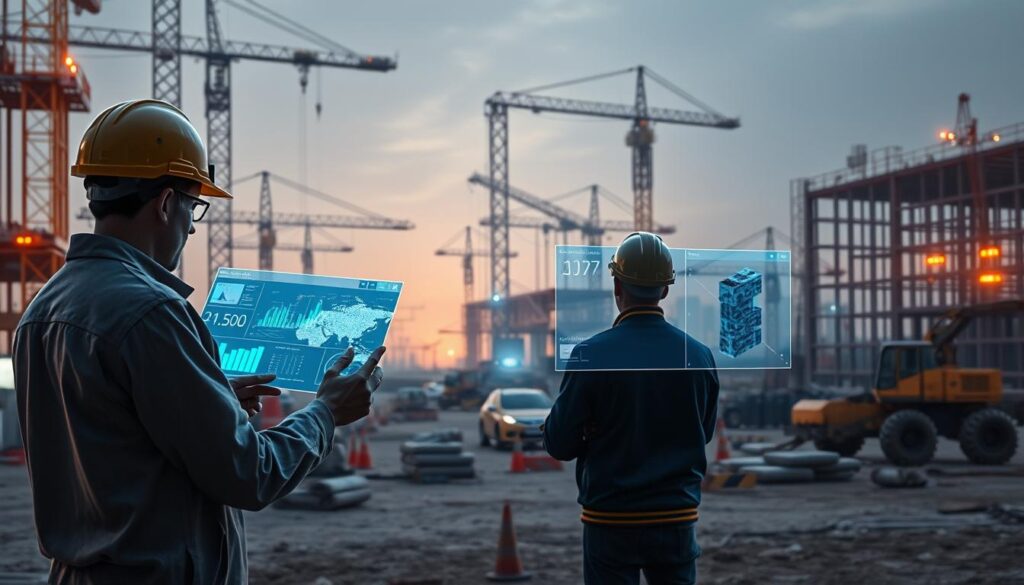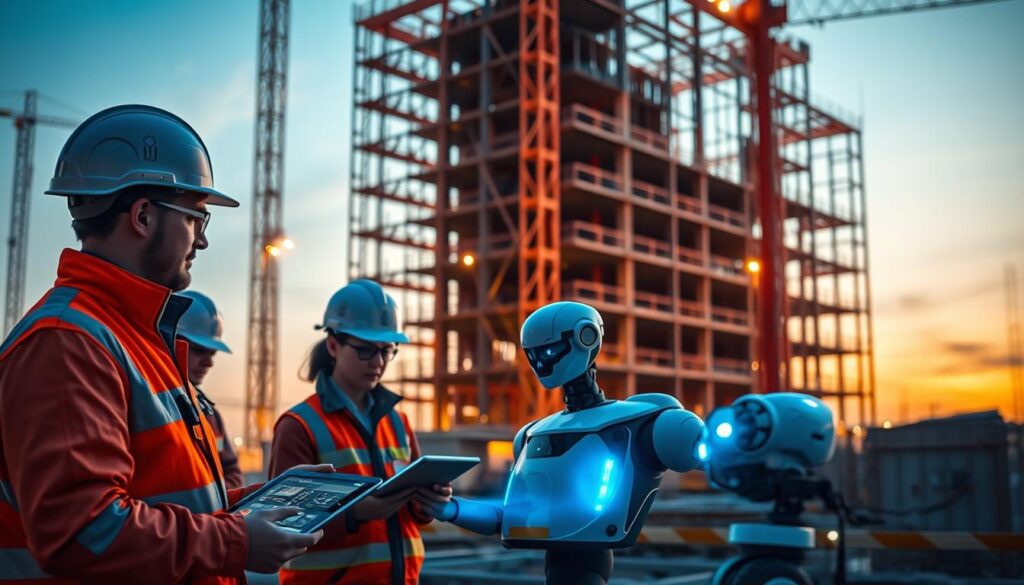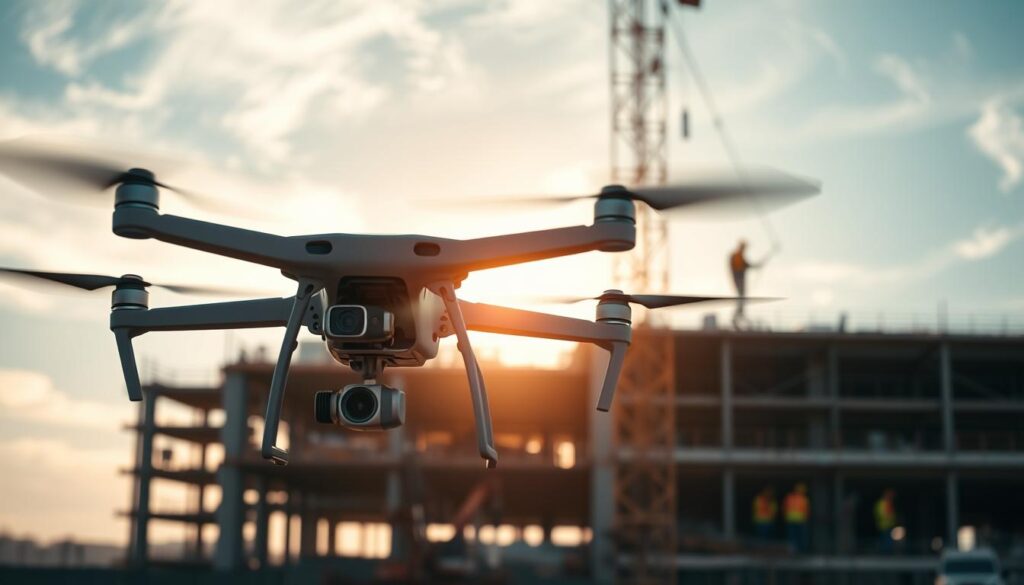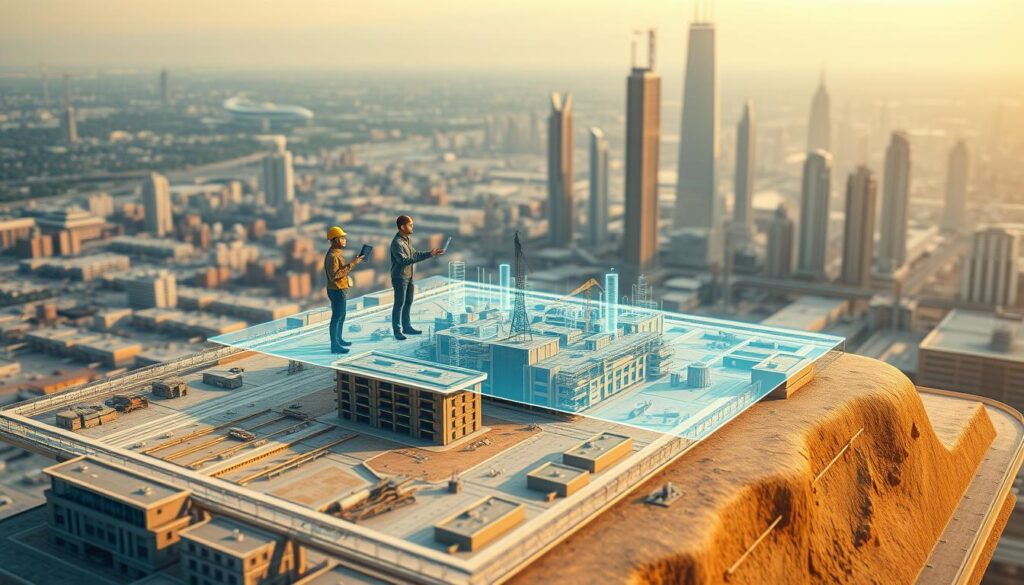Can Artificial Intelligence (AI) revolutionize the way we design, build, and maintain infrastructure? The answer lies in the transformative power of AI technology in civil engineering.
The civil engineering industry is on the cusp of a significant transformation with the integration of AI. By leveraging AI-driven tools and techniques, professionals in the field can improve efficiency, safety, and innovation in projects.
This integration is not just about adopting new technology; it’s about revolutionizing the way we work. AI is being used to analyze complex data, predict potential issues, and optimize project outcomes.
Key Takeaways
- AI is transforming the civil engineering industry by improving efficiency and safety.
- The use of AI-driven tools is enhancing innovation in civil engineering projects.
- AI technology is being leveraged to analyze complex data and predict potential issues.
- The integration of AI is revolutionizing the way civil engineers work.
- AI is optimizing project outcomes in the civil engineering sector.
Introduction to AI in Civil Engineering
The integration of Artificial Intelligence (AI) into civil engineering is revolutionizing the way infrastructure projects are designed, constructed, and maintained. As we explore the potential of AI in this field, it’s essential to understand the basics of AI and its relevance to civil engineering.
What Is AI?
Artificial Intelligence refers to the development of computer systems that can perform tasks that typically require human intelligence, such as learning, problem-solving, and decision-making. In the context of civil engineering, AI can be used to analyze complex data, predict outcomes, and optimize processes, thereby enhancing the efficiency and accuracy of projects.
The impact of AI on civil engineering is significant, as it enables engineers to make more informed decisions, reduce costs, and improve project timelines. By leveraging AI algorithms and machine learning techniques, civil engineers can automate routine tasks, identify potential issues early, and develop more effective solutions.
Overview of Civil Engineering
Civil engineering is a professional engineering discipline that deals with the design, construction, and maintenance of the physical and naturally built environment. This includes infrastructure projects such as roads, bridges, canals, and buildings. The field requires a deep understanding of mathematics, physics, and materials science, as well as the ability to manage complex projects and collaborate with various stakeholders.
The application of artificial intelligence in the construction industry is transforming the way civil engineers work. From predictive maintenance to optimized resource allocation, AI is enhancing the capabilities of civil engineers and enabling them to deliver projects more efficiently and sustainably.
The Role of AI in Construction Project Management
The integration of AI in construction project management is revolutionizing the way projects are planned and executed. By leveraging AI algorithms, construction companies can analyze vast amounts of data to predict project outcomes, identify potential risks, and optimize resource allocation.
Enhanced Planning and Scheduling
AI significantly enhances planning and scheduling in construction projects. Predictive analytics enables project managers to forecast potential delays and adjust schedules accordingly. This proactive approach ensures that projects stay on track, reducing the likelihood of costly delays.
For instance, AI can analyze historical data and real-time site conditions to optimize the scheduling of tasks. This leads to more efficient use of resources and labor, ultimately resulting in cost savings and improved project timelines.

Risk Management
Risk management is a critical aspect of construction project management. AI applications in civil infrastructure help identify potential risks early in the project lifecycle. By analyzing data from various sources, AI can predict potential hazards and suggest mitigation strategies.
A key benefit of AI in risk management is its ability to analyze complex data sets quickly and accurately. This enables project managers to make informed decisions and take proactive measures to mitigate risks.
| Risk Management Aspect | Traditional Method | AI-Enhanced Method |
|---|---|---|
| Risk Identification | Manual assessment by experts | AI-driven data analysis |
| Risk Mitigation | Reactive measures based on experience | Proactive strategies based on predictive analytics |
| Risk Monitoring | Periodic reviews | Continuous monitoring with real-time data |
By adopting AI-enhanced risk management, construction companies can reduce the likelihood of project disruptions and improve overall project safety.
AI in Structural Design
With AI, structural design is becoming more efficient and innovative. The use of artificial intelligence in this field is not only enhancing the design process but also improving the overall quality and safety of structures.
Automated Design Tools
AI-powered automated design tools are revolutionizing the way engineers create structural designs. These tools can generate optimal design solutions based on various parameters such as load, material, and environmental conditions. By automating the design process, engineers can save time and focus on more complex and creative tasks.
The benefits of automated design tools include:
- Increased efficiency
- Improved accuracy
- Enhanced creativity
Predictive Analytics
Predictive analytics is another area where AI is making a significant impact in structural design. By analyzing data from various sources, AI algorithms can predict the performance of structures under different conditions, such as natural disasters or heavy loads. This enables engineers to identify potential issues before they become major problems.
| Predictive Analytics Benefits | Description |
|---|---|
| Improved Safety | Predictive analytics helps identify potential structural issues before they become major problems. |
| Reduced Maintenance Costs | By predicting when maintenance is required, costs can be significantly reduced. |
| Enhanced Decision Making | Predictive analytics provides valuable insights that can inform design and maintenance decisions. |
The integration of AI in structural design is set to continue transforming the field of civil engineering. As AI technology advances, we can expect to see even more innovative applications in the future.
Improving Safety Measures with AI
Safety in civil engineering is being taken to the next level with the advent of AI technologies. The construction industry, known for its high-risk environment, is leveraging AI to predict and prevent accidents, thereby enhancing overall safety.
Real-Time Monitoring
One of the significant ways AI is improving safety is through real-time monitoring of construction sites. AI-powered systems can analyze data from various sensors and cameras to detect potential hazards, such as structural weaknesses or unsafe worker behavior.
For instance, AI-driven monitoring systems can track the movement of workers and machinery, alerting site managers to potential collisions or other safety risks. This proactive approach to safety can significantly reduce the likelihood of accidents.

Hazard Prediction
AI’s ability to analyze vast amounts of data makes it an invaluable tool for hazard prediction. By examining historical data and real-time inputs, AI algorithms can identify patterns that may indicate potential safety risks.
For example, AI can analyze weather forecasts, site conditions, and equipment status to predict the likelihood of accidents. This enables project managers to take preventive measures, such as halting work during hazardous conditions or reinforcing structures to withstand predicted weather events.
By integrating AI into safety protocols, civil engineering projects can not only reduce the risk of accidents but also improve compliance with safety regulations. As the technology continues to evolve, we can expect to see even more innovative applications of AI in enhancing safety measures.
AI for Environmental Impact Analysis
AI is playing a crucial role in enhancing the sustainability of civil engineering projects through comprehensive environmental impact analyses. By leveraging AI technology, civil engineers can now conduct more accurate and efficient assessments of how their projects might affect the environment.
The use of AI in environmental impact analysis allows for the processing of vast amounts of data, including environmental conditions, project specifications, and potential risks. This enables project managers to make informed decisions that minimize environmental harm.
Sustainability Assessments
Sustainability assessments are a critical component of environmental impact analysis. AI algorithms can analyze data from various sources to predict the long-term sustainability of a project. This includes assessing energy consumption, material usage, and waste management practices.
For instance, AI can help optimize building designs to reduce energy consumption by analyzing factors such as orientation, insulation, and window placement. This not only reduces the environmental footprint but also lowers operational costs over the project’s lifecycle.
Resource Management
Effective resource management is essential for minimizing the environmental impact of civil engineering projects. AI can optimize resource allocation by predicting demand, identifying potential bottlenecks, and suggesting alternatives.
For example, AI can analyze historical data and real-time information to optimize the supply chain for construction materials, reducing waste and minimizing the carbon footprint associated with transportation.
| Aspect | Traditional Method | AI-Enhanced Method |
|---|---|---|
| Sustainability Assessment | Manual analysis, limited data | Comprehensive data analysis, predictive modeling |
| Resource Management | Reactive, based on historical data | Proactive, predictive analytics |
By adopting AI for environmental impact analysis, civil engineers can not only comply with regulatory requirements but also contribute to a more sustainable future. The integration of AI technology in civil engineering projects is a step towards achieving environmentally friendly and sustainable infrastructure development.
The Future of Smart Cities
The future of urban living is being shaped by AI, revolutionizing the way cities are planned and managed. As the world becomes increasingly urbanized, the need for efficient, sustainable, and livable cities has never been more pressing.

AI is playing a pivotal role in this transformation, particularly in urban planning and infrastructure management. By leveraging AI algorithms, cities can optimize their planning processes, making them more responsive to the needs of their citizens.
AI in Urban Planning
AI is enhancing urban planning in several ways. It can analyze vast amounts of data to identify patterns and trends, helping planners make informed decisions. For instance, AI can predict population growth, traffic congestion, and energy demand, allowing cities to prepare accordingly.
Some of the key benefits of AI in urban planning include:
- Improved data analysis for better decision-making
- Enhanced predictive capabilities for urban development
- More efficient allocation of resources
Infrastructure Monitoring and Maintenance
AI is also crucial for the monitoring and maintenance of urban infrastructure. By using sensors and IoT devices, cities can monitor the condition of their infrastructure in real-time, predicting when maintenance is required.
| Infrastructure | AI Application | Benefit |
|---|---|---|
| Roads | Predictive maintenance | Reduced congestion and improved safety |
| Bridges | Structural health monitoring | Early detection of potential failures |
| Buildings | Energy efficiency optimization | Lower energy costs and reduced carbon footprint |
By embracing AI, cities can create a more sustainable, efficient, and livable environment for their citizens. The role of AI in urban planning and infrastructure management is set to continue growing, shaping the future of smart cities.
Cost Savings Through AI Integration
By leveraging AI, civil engineering projects can now achieve unprecedented levels of cost savings through improved planning and execution. The integration of AI in civil infrastructure is transforming the way projects are managed, from design to completion.
Reducing Labor Costs
Automating Tasks
One of the significant advantages of AI in civil engineering is its ability to automate repetitive and time-consuming tasks, thereby reducing labor costs. AI-powered tools can analyze data, identify patterns, and make predictions, freeing up human resources for more complex and creative tasks.
For instance, AI-driven algorithms can automate the process of monitoring construction sites, detecting potential issues before they become major problems. This not only saves time but also reduces the need for manual inspections, leading to cost savings.
Example: A construction company in the United States implemented an AI-powered monitoring system, which resulted in a 15% reduction in labor costs due to the automation of site inspections and issue detection.
Optimizing Resource Allocation
AI can also optimize resource allocation by analyzing project requirements and predicting the necessary resources. This ensures that the right materials and equipment are available at the right time, reducing waste and minimizing delays.
Minimizing Material Waste
Precision Planning
AI can help minimize material waste by optimizing designs and construction plans. Through predictive analytics, AI can identify potential waste generation areas and suggest alternatives that reduce waste.
- AI-driven design tools can create optimized building designs that use materials more efficiently.
- Predictive maintenance can help prevent equipment failures, reducing the need for spare parts and minimizing waste.
By adopting AI in civil engineering, projects can not only achieve significant cost savings but also contribute to a more sustainable future.
Enhancing Communication in Civil Projects
The integration of AI in civil engineering is enhancing project communication, making it more streamlined and precise. Effective communication is crucial for the success of civil engineering projects, and AI is playing a vital role in improving collaboration among team members and stakeholders.

AI-Driven Collaboration Tools
AI-driven collaboration tools are being increasingly adopted in civil engineering to facilitate better communication and project management. These tools use machine learning algorithms to analyze data and provide insights that help teams make informed decisions. For instance, AI-powered project management software can predict potential delays and suggest mitigation strategies, ensuring that projects stay on track.
Key Features of AI-Driven Collaboration Tools:
- Real-time data analysis and reporting
- Predictive analytics for project forecasting
- Automated task assignment and tracking
- Enhanced team collaboration through integrated communication platforms
Stakeholder Engagement
AI is also enhancing stakeholder engagement by providing real-time updates and insights into project progress. This is particularly important for civil engineering projects, which often involve multiple stakeholders with varying interests. AI-powered stakeholder engagement platforms can analyze stakeholder feedback and provide actionable insights, helping project managers to address concerns and improve overall project satisfaction.
“AI is transforming the way we engage with stakeholders, making it more proactive and responsive.” –
By leveraging AI-driven collaboration tools and stakeholder engagement platforms, civil engineering projects can achieve better outcomes, reduced costs, and improved stakeholder satisfaction. As the industry continues to adopt AI technology, we can expect to see even more innovative solutions emerge.
AI in Geotechnical Engineering
The integration of Artificial Intelligence (AI) in geotechnical engineering is revolutionizing the way we approach complex soil analysis and predictive modeling. Geotechnical engineering, a vital aspect of civil engineering, involves the analysis of earth’s materials, such as soil and rock, to design and construct infrastructure projects like tunnels, foundations, and slopes. The application of AI in this field is enhancing the accuracy, efficiency, and reliability of these analyses.
Soil Analysis Automation
One of the significant benefits of AI in geotechnical engineering is the automation of soil analysis. Traditional soil analysis methods can be time-consuming and prone to human error. AI algorithms, however, can quickly process large datasets related to soil properties, such as density, moisture content, and shear strength, to predict soil behavior under different conditions. This automation not only speeds up the analysis process but also improves the accuracy of the results.
Key advantages of AI-driven soil analysis automation include:
- Enhanced accuracy in soil property predictions
- Reduced time for analysis, allowing for faster project timelines
- Ability to handle complex datasets that would be challenging for human analysts
Predictive Modeling
AI is also being used to develop predictive models in geotechnical engineering. These models can forecast various geotechnical phenomena, such as landslides, soil liquefaction, and settlement of foundations. By analyzing historical data and using machine learning algorithms, AI can identify patterns and predict potential issues before they occur. This predictive capability enables engineers to design more robust and resilient structures, reducing the risk of failures and improving overall project safety.
The benefits of AI-driven predictive modeling in geotechnical engineering are multifaceted:
- Improved safety through the early identification of potential geotechnical hazards
- Optimized design solutions based on predictive insights
- Reduced maintenance costs over the lifecycle of infrastructure projects
In conclusion, the integration of AI in geotechnical engineering is transforming the field by automating soil analysis and enhancing predictive modeling capabilities. These advancements are contributing to more efficient, accurate, and safe geotechnical engineering practices, ultimately benefiting the broader civil engineering community.
The Use of Drones in Civil Engineering
The integration of drones in civil engineering has revolutionized the way projects are planned and executed. Drones, equipped with AI technology, are capable of capturing and analyzing data with unprecedented precision.
Aerial Surveys
Drones have transformed aerial surveys by providing high-resolution imagery and topographical data. This information is crucial for project planning, allowing engineers to assess site conditions accurately.

- Enhanced accuracy in topographical data
- Improved project planning and execution
- Reduced costs associated with traditional survey methods
Site Inspections
AI-powered drones are also being used for site inspections, enabling real-time monitoring of construction progress. This capability allows for the early detection of potential issues, ensuring that projects stay on track.
“The integration of AI with drone technology has opened new avenues for efficient project management in civil engineering.” – Industry Expert
The use of drones in civil engineering not only enhances the accuracy of data collection but also improves the overall efficiency of projects. As the technology continues to evolve, we can expect to see even more innovative applications in the field.
Building Information Modeling (BIM) and AI
The integration of Artificial Intelligence (AI) with Building Information Modeling (BIM) is revolutionizing the civil engineering landscape. BIM serves as a digital representation of the physical and functional characteristics of a project, and AI enhances its capabilities by improving data management and clash detection.
With AI, BIM processes become more efficient and accurate. AI algorithms can analyze vast amounts of data generated during the BIM process, identifying patterns and potential issues that might be overlooked by human engineers.
Improved Data Management
AI enhances data management in BIM by automating data classification, validation, and enrichment. This leads to more accurate and consistent data, reducing errors and miscommunications among project stakeholders.
Key benefits of AI in BIM data management include:
- Automated data classification
- Data validation against project standards
- Data enrichment through integration with external data sources
Clash Detection
Clash detection is a critical aspect of BIM that involves identifying conflicts between different building components. AI can significantly improve clash detection by analyzing BIM data and predicting potential clashes before they occur.
The advantages of AI-driven clash detection include:
- Early detection of potential clashes
- Reduced rework and cost savings
- Improved project timelines
The integration of AI with BIM is transforming the civil engineering industry by improving data management and clash detection. As the industry continues to adopt these technologies, we can expect to see significant improvements in project efficiency and accuracy.
| Feature | Traditional BIM | AI-Enhanced BIM |
|---|---|---|
| Data Management | Manual data classification and validation | Automated data classification and validation |
| Clash Detection | Rule-based clash detection | AI-driven predictive clash detection |
AI in Project Visualization
With AI-driven project visualization, civil engineers can now create more immersive and interactive models. This advancement is significantly enhancing stakeholder engagement and project understanding.
The use of AI in project visualization is primarily seen in two areas: Virtual Reality (VR) Simulations and 3D Modeling. These technologies are revolutionizing the way projects are designed, reviewed, and executed.
Virtual Reality Simulations
AI-powered VR simulations allow for a more immersive experience, enabling stakeholders to virtually walk through a project. This can help identify potential issues early on, improve communication among team members, and enhance client satisfaction.
For instance, VR simulations can be used to:
- Visualize complex infrastructure projects
- Conduct virtual site inspections
- Train personnel in a simulated environment
3D Modeling
AI-enhanced 3D modeling is another critical aspect of project visualization. It enables the creation of detailed, accurate models that can be easily manipulated and analyzed.
Some benefits of AI-driven 3D modeling include:
| Benefit | Description |
|---|---|
| Improved Accuracy | AI algorithms can reduce errors in modeling |
| Enhanced Collaboration | Stakeholders can interact with the model in real-time |
| Increased Efficiency | Automated processes speed up the modeling process |
As shown in the table, AI-driven 3D modeling offers numerous advantages that can streamline the project visualization process.

The impact of AI on civil engineering, particularly in project visualization, is profound. By leveraging VR simulations and 3D modeling, civil engineers can create more engaging, accurate, and interactive project visualizations.
Machine Learning for Infrastructure Management
Machine learning, a subset of AI, is revolutionizing infrastructure management by predicting maintenance needs and optimizing performance. This technology is being increasingly adopted in civil engineering to enhance the longevity and efficiency of infrastructure.
The application of machine learning in infrastructure management involves analyzing vast amounts of data from various sources, including sensors and maintenance records. This data-driven approach enables civil engineers to make informed decisions regarding maintenance and repairs.
Predictive Maintenance
Predictive maintenance is a key benefit of integrating machine learning into infrastructure management. By analyzing historical data and real-time sensor readings, machine learning algorithms can predict when maintenance is required, reducing the likelihood of unexpected failures.
Benefits of Predictive Maintenance:
- Reduced downtime
- Lower maintenance costs
- Extended infrastructure lifespan
The use of predictive maintenance allows for a proactive approach to infrastructure management, minimizing the risk of catastrophic failures and ensuring the continuous operation of critical infrastructure.
Performance Optimization
Machine learning also plays a crucial role in optimizing infrastructure performance. By analyzing data on infrastructure usage and condition, machine learning algorithms can identify areas for improvement and recommend optimizations.
Performance optimization through machine learning involves:
- Analyzing infrastructure usage patterns
- Identifying potential bottlenecks
- Recommending maintenance and upgrade schedules
| Aspect | Traditional Method | Machine Learning Approach |
|---|---|---|
| Maintenance Scheduling | Based on fixed schedules or reactive measures | Predictive, based on real-time data and historical analysis |
| Performance Analysis | Manual analysis, potentially missing critical insights | Automated, comprehensive analysis providing detailed insights |
The integration of machine learning in infrastructure management is a significant step forward in civil engineering, offering numerous benefits including improved efficiency, reduced costs, and enhanced infrastructure longevity.
AI-Enabled Surveying Techniques
The use of AI in surveying is significantly improving data collection and analysis in civil engineering. AI-enabled surveying techniques are being increasingly adopted to enhance the accuracy and efficiency of construction projects.

Precision Mapping
Precision mapping is a critical component of surveying that involves creating detailed maps of the terrain. AI algorithms can process large datasets quickly, enabling surveyors to create highly accurate maps. This technology is particularly useful in complex projects where precise measurements are crucial.
Benefits of Precision Mapping:
- Improved accuracy in data collection
- Enhanced project planning and execution
- Reduced errors in measurement
Terrain Analysis
Terrain analysis is another vital aspect of surveying that involves studying the topography of a site. AI-powered terrain analysis tools can analyze data from various sources, including drones and satellite imagery, to provide a comprehensive understanding of the terrain.
| Feature | Traditional Surveying | AI-Enabled Surveying |
|---|---|---|
| Accuracy | Moderate | High |
| Speed | Slow | Fast |
| Data Analysis | Manual | Automated |
By leveraging AI-enabled surveying techniques, civil engineers can make more informed decisions, reduce project timelines, and improve overall project outcomes.
Ethical Considerations in AI Implementation
AI applications in civil infrastructure are revolutionizing the field, yet they also introduce ethical dilemmas that require careful consideration. As the industry continues to adopt AI technologies, it’s essential to address the ethical concerns that arise from their implementation.
The use of AI in civil engineering involves handling vast amounts of data, which raises significant data privacy concerns. Ensuring the security and privacy of this data is paramount to maintaining public trust and complying with regulatory requirements.
Data Privacy Concerns
To mitigate data privacy risks, companies can implement robust data protection policies, including encryption and secure data storage solutions. Regular audits and compliance checks can also help in identifying and addressing potential vulnerabilities.
Another critical ethical issue is bias and fairness in AI decision-making. AI systems can perpetuate existing biases if they are trained on biased data, leading to unfair outcomes.
Bias and Fairness Issues
To address bias, it’s crucial to develop AI systems that are transparent and explainable. This can be achieved by using diverse and representative data sets for training AI models and implementing fairness-aware algorithms. Continuous monitoring and testing for bias can also help in ensuring that AI decisions are fair and equitable.
By prioritizing ethical considerations, the civil engineering industry can ensure that AI technologies are developed and implemented in a responsible and ethical manner. This not only enhances the industry’s reputation but also fosters public trust in AI-driven solutions.
Conclusion: Embracing AI in Engineering Practice
The integration of AI in civil engineering is revolutionizing the way projects are managed, designed, and executed. From enhancing planning and scheduling to improving safety measures and reducing costs, AI’s impact on civil engineering is profound.
Transforming the Future of Civil Engineering
As AI continues to evolve, its influence on civil engineering will only grow. By embracing AI technologies, professionals in the field can look forward to improved project outcomes, increased efficiency, and enhanced sustainability. Understanding how AI is changing civil engineering is crucial for staying ahead in this rapidly advancing field.
The impact of AI on civil engineering is not just about adopting new technologies; it’s about transforming the way we work, collaborate, and innovate. As we move forward, it’s clear that AI will play a vital role in shaping the future of civil engineering.

Pingback: Advanced Building Tech Integration for Smart Cities USA
Pingback: Unlock the Future: Exploring AI in Civil Engineering